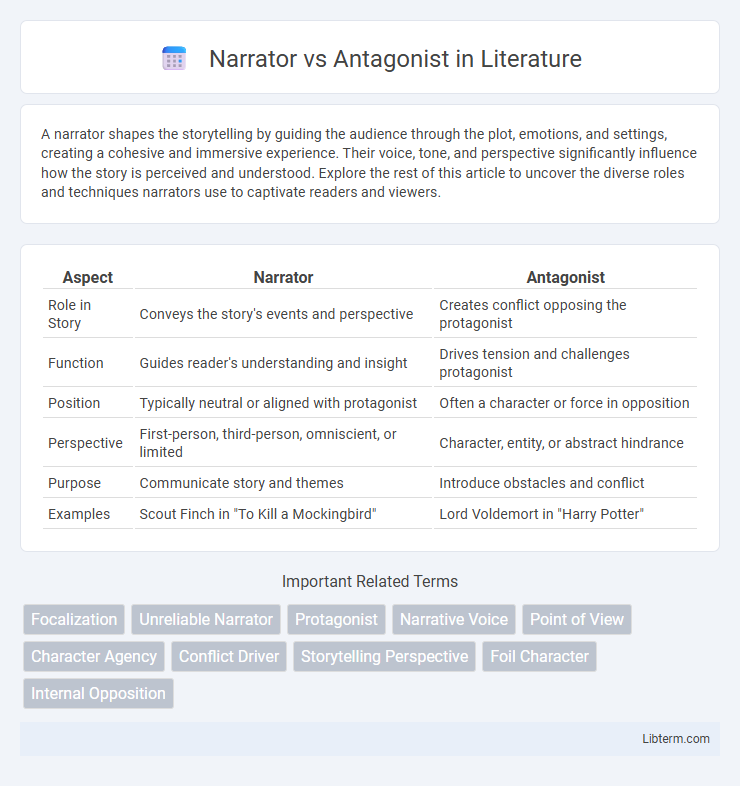A narrator shapes the storytelling by guiding the audience through the plot, emotions, and settings, creating a cohesive and immersive experience. Their voice, tone, and perspective significantly influence how the story is perceived and understood. Explore the rest of this article to uncover the diverse roles and techniques narrators use to captivate readers and viewers.
Table of Comparison
| Aspect | Narrator | Antagonist |
|---|---|---|
| Role in Story | Conveys the story's events and perspective | Creates conflict opposing the protagonist |
| Function | Guides reader's understanding and insight | Drives tension and challenges protagonist |
| Position | Typically neutral or aligned with protagonist | Often a character or force in opposition |
| Perspective | First-person, third-person, omniscient, or limited | Character, entity, or abstract hindrance |
| Purpose | Communicate story and themes | Introduce obstacles and conflict |
| Examples | Scout Finch in "To Kill a Mockingbird" | Lord Voldemort in "Harry Potter" |
Defining the Narrator: Role and Perspective
The narrator serves as the voice guiding the story, offering insight into events and characters through a specific narrative perspective such as first-person, third-person limited, or omniscient. Unlike the antagonist, who actively works against the protagonist within the plot, the narrator's role is to present the story's details, shape readers' understanding, and influence interpretation through tone and reliability. The narrator's perspective determines the scope of information revealed, directly impacting how conflicts and character motivations, including those of the antagonist, are perceived.
Understanding the Antagonist: Purpose in the Story
The antagonist serves as the primary source of conflict, challenging the protagonist and driving the narrative forward. Understanding the antagonist's motivations, goals, and flaws reveals deeper themes and adds complexity to the story's message. This opposition shapes the protagonist's growth and highlights key moral and emotional struggles within the plot.
Narrator Types: First-Person, Third-Person, and Omniscient
The narrator in literature can take various forms, including first-person, third-person, and omniscient perspectives, each shaping the story's delivery and reader's engagement differently. First-person narrators offer intimate insights through their own eyes, creating subjective and limited viewpoints, while third-person narrators provide an external perspective that can be either limited or objective, focusing on one character or multiple characters without personal involvement. Omniscient narrators possess complete knowledge of all characters, events, and internal thoughts, delivering a comprehensive and all-encompassing narrative contrasting with the antagonist, who opposes the protagonist within the story's plot.
Antagonist Archetypes: Classic and Modern Examples
Antagonist archetypes embody various roles such as the classic villain, including characters like Darth Vader and Moriarty, who directly oppose protagonists through clear malevolence. Modern antagonists often possess complex motivations and moral ambiguity, exemplified by characters like Killmonger in "Black Panther" and Thanos in the Marvel Cinematic Universe. These evolving antagonist profiles enhance narrative depth by challenging traditional notions of good versus evil, enriching story dynamics beyond the narrator's perspective.
Key Differences Between Narrator and Antagonist
The narrator is the voice or character who tells the story, providing perspective, insight, and context, while the antagonist is a character or force that opposes the protagonist, creating conflict. The narrator controls the narrative flow and shapes the reader's understanding, whereas the antagonist drives tension and challenges the protagonist's goals. Unlike the narrator, who may be neutral or biased, the antagonist's role is primarily to obstruct and create obstacles within the plot.
How Narrators Shape Reader Perception
Narrators shape reader perception by controlling the flow of information, framing events through their tone and reliability, which influences emotional engagement and interpretation of characters, especially the antagonist. A reliable narrator can create a clear moral contrast between protagonist and antagonist, while an unreliable narrator complicates or even blurs these roles, fostering ambiguity and deeper analysis. The narrator's perspective determines how the antagonist's motives and actions are understood, shaping the reader's empathy or aversion toward them.
The Antagonist’s Influence on Plot Development
The antagonist drives plot development by creating conflict and challenging the protagonist's goals, which intensifies the story's tension and stakes. Their actions and decisions force the protagonist to adapt, revealing character growth and advancing the narrative arc. The interplay between antagonist and protagonist forms the backbone of the story's dynamic progression and thematic depth.
When the Narrator Is Also the Antagonist
When the narrator assumes the role of the antagonist, the story gains a complex, unreliable perspective that challenges readers to question the truth. This dual role creates tension and ambiguity, as the narrator's motives and biases directly influence the plot's conflict. Notable examples include Patrick Bateman in "American Psycho" and Humbert Humbert in "Lolita," where the intertwining of narration and antagonism deepens psychological insight and thematic complexity.
Narrative Reliability vs. Antagonistic Motivation
Narrative reliability determines how truthfully the narrator conveys the story, influencing reader trust and interpretation, while antagonistic motivation drives conflicts through the antagonist's goals and intentions. A reliable narrator provides an accurate perspective, clarifying the antagonist's motives and actions, whereas an unreliable narrator may distort or obscure the antagonist's true purpose. Understanding both elements enhances the depth of plot development and character complexity in storytelling.
Impact on Storytelling: Narrator and Antagonist Interplay
The interplay between the narrator and antagonist significantly shapes storytelling by influencing reader perspective and tension development. A biased or unreliable narrator can deepen the antagonist's menace, creating ambiguity and heightening suspense, while an omniscient narrator offers clear insight into the antagonist's motives, enriching thematic complexity. This dynamic drives plot progression and emotional engagement, as the narrator's portrayal frames the antagonist's role in conflict and resolution.
Narrator Infographic

 libterm.com
libterm.com